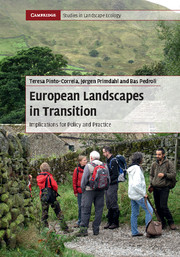Book contents
- European Landscapes in Transition
- Cambridge Studies in Landscape Ecology
- European Landscapes in Transition
- Copyright page
- Contents
- Foreword
- Preface
- Acknowledgements
- 1 Introduction: A Landscape in Disequilibrium
- 2 What Is the Rural Landscape About?
- 3 Conceptualising Rural Landscape Change
- 4 Evolving Activities in the Rural
- 5 Changing Relationships between the Rural and the City
- 6 Landscape Policy and Planning – Managing Conflicts and Making Places
- 7 Common Grounds for Colourful Futures
- Bibliography
- Index
- References
Bibliography
Published online by Cambridge University Press: 17 January 2018
- European Landscapes in Transition
- Cambridge Studies in Landscape Ecology
- European Landscapes in Transition
- Copyright page
- Contents
- Foreword
- Preface
- Acknowledgements
- 1 Introduction: A Landscape in Disequilibrium
- 2 What Is the Rural Landscape About?
- 3 Conceptualising Rural Landscape Change
- 4 Evolving Activities in the Rural
- 5 Changing Relationships between the Rural and the City
- 6 Landscape Policy and Planning – Managing Conflicts and Making Places
- 7 Common Grounds for Colourful Futures
- Bibliography
- Index
- References
- Type
- Chapter
- Information
- European Landscapes in TransitionImplications for Policy and Practice, pp. 254 - 282Publisher: Cambridge University PressPrint publication year: 2018



